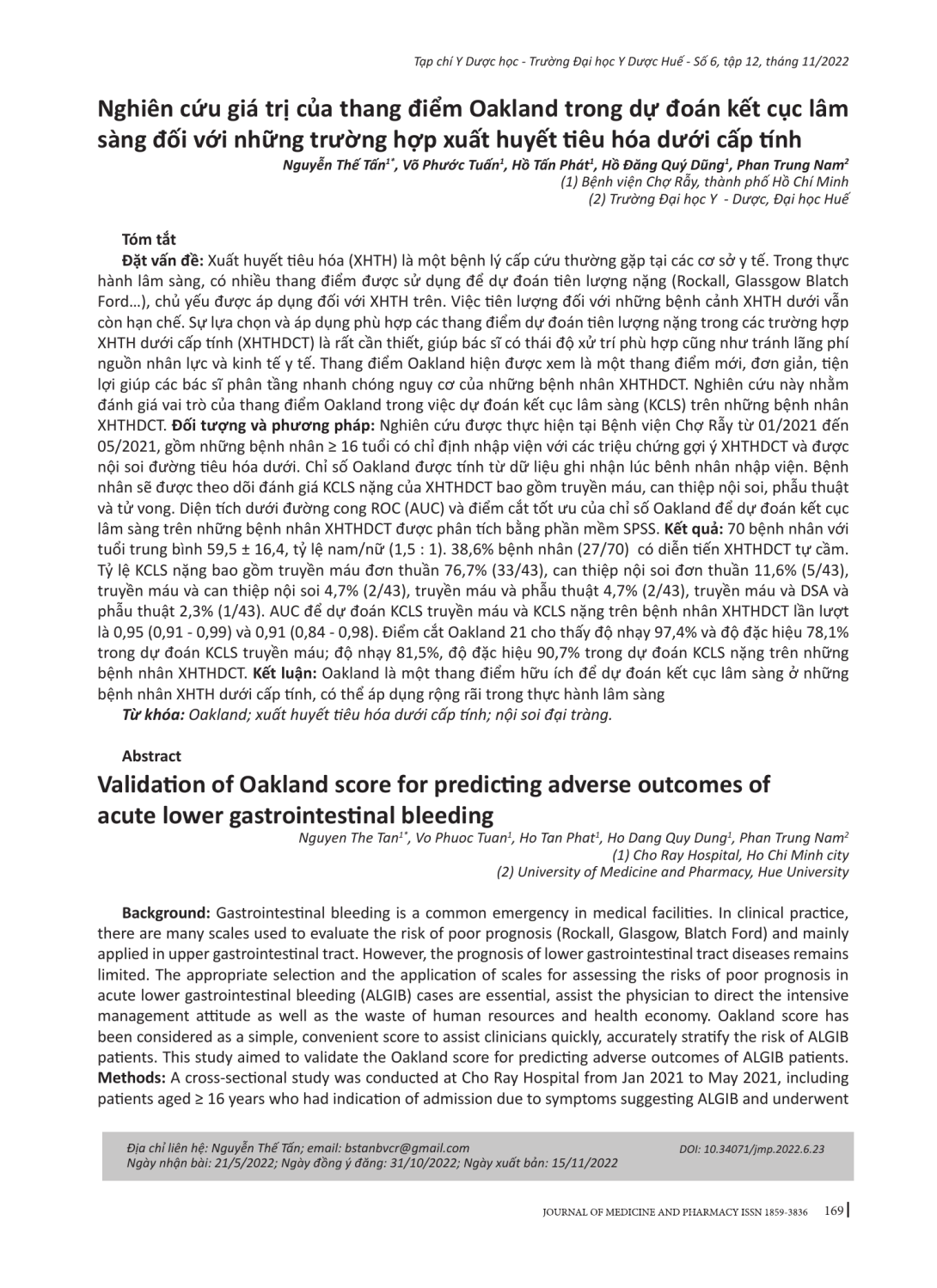
Đánh giá vai trò của thang điểm Oakland trong việc dự đoán kết cục lâm sàng (KCLS) trên những bệnh nhân XHTHDCT. Đối tượng và phương pháp: Nghiên cứu được thực hiện tại Bệnh viện Chợ Rẫy từ 01/2021 đến 05/2021, gồm những bệnh nhân ≥ 16 tuổi có chỉ định nhập viện với các triệu chứng gợi ý XHTHDCT và được nội soi đường tiêu hóa dưới. Chỉ số Oakland được tính từ dữ liệu ghi nhận lúc bênh nhân nhập viện. Bệnh nhân sẽ được theo dõi đánh giá KCLS nặng của XHTHDCT bao gồm truyền máu, can thiệp nội soi, phẫu thuật và tử vong. Diện tích dưới đường cong ROC (AUC) và điểm cắt tốt ưu của chỉ số Oakland để dự đoán kết cục lâm sàng trên những bệnh nhân XHTHDCT được phân tích bằng phần mềm SPSS. Kết quả: 70 bệnh nhân với tuổi trung bình 59,5 ± 16,4, tỷ lệ nam/nữ (1,5 : 1). 38,6% bệnh nhân (27/70) có diễn tiến XHTHDCT tự cầm. Tỷ lệ KCLS nặng bao gồm truyền máu đơn thuần 76,7% (33/43), can thiệp nội soi đơn thuần 11,6% (5/43), truyền máu và can thiệp nội soi 4,7% (2/43), truyền máu và phẫu thuật 4,7% (2/43), truyền máu và DSA và phẫu thuật 2,3% (1/43). AUC để dự đoán KCLS truyền máu và KCLS nặng trên bệnh nhân XHTHDCT lần lượt là 0,95 (0,91 - 0,99) và 0,91 (0,84 - 0,98). Điểm cắt Oakland 21 cho thấy độ nhạy 97,4% và độ đặc hiệu 78,1% trong dự đoán KCLS truyền máu; độ nhạy 81,5%, độ đặc hiệu 90,7% trong dự đoán KCLS nặng trên những bệnh nhân XHTHDCT. Kết luận: Oakland là một thang điểm hữu ích để dự đoán kết cục lâm sàng ở những bệnh nhân XHTH dưới cấp tính, có thể áp dụng rộng rãi trong thực hành lâm sàng
Gastrointestinal bleeding is a common emergency in medical facilities. In clinical practice, there are many scales used to evaluate the risk of poor prognosis (Rockall, Glasgow, Blatch Ford) and mainly applied in upper gastrointestinal tract. However, the prognosis of lower gastrointestinal tract diseases remains limited. The appropriate selection and the application of scales for assessing the risks of poor prognosis in acute lower gastrointestinal bleeding (ALGIB) cases are essential, assist the physician to direct the intensive management attitude as well as the waste of human resources and health economy. Oakland score has been considered as a simple, convenient score to assist clinicians quickly, accurately stratify the risk of ALGIB patients. This study aimed to validate the Oakland score for predicting adverse outcomes of ALGIB patients. Methods: A cross-sectional study was conducted at Cho Ray Hospital from Jan 2021 to May 2021, including patients aged ≥ 16 years who had indication of admission due to symptoms suggesting ALGIB and underwent lower gastrointestinal endoscopy. These patients were then followed-up to observe the adverse outcomes, including blood transfusion, endoscopic intervention, surgery and death. Area under the receiver operating characteristic curve (AUC) and the best cut-off value of Oakland score for predicting adverse outcomes of ALGIB patients were analyzed using SPSS software. Results: A total of 70 patients with mean age 59.5 ± 16.4, male/female ratio (1.5 : 1) was recruited in this study. 27/70 (38.6%) stopped bleeding spontaneously without any interventions. The rate of clinical outcomes was blood transfusion (33/43, 76.7%), endoscopic intervention (5/43, 11.6%), blood transfusion plus endoscopic intervention (2/43, 4.7%), blood transfusion plus surgery (2/43, 4.7%), blood transfusion plus DSA plus surgery (1/43, 2.3%), respectively. AUC for predicting blood transfusion and adverse outcomes of ALGIB patients were 0.95 (0.91 - 0.99) and 0.91 (0.84 - 0.98), respectively. Oakland score threshold of 21 showed that sensitivity and specificity for predicting blood transfusion were 94.7% and 78.1%, sensitivity and specificity for predicting adverse outcomes of ALGIB patients were 81.5% and 90.7% respectively. Conclusions: Oakland is an excellent score in order to predict clinical outcomes on ALGIB patients.
- Đăng nhập để gửi ý kiến
